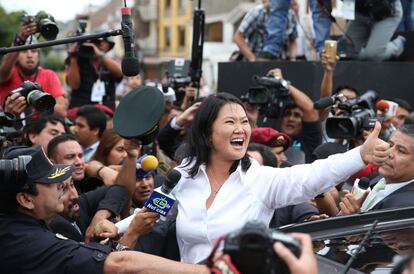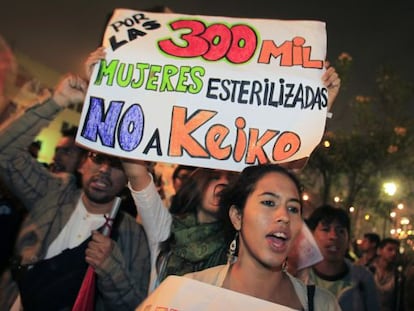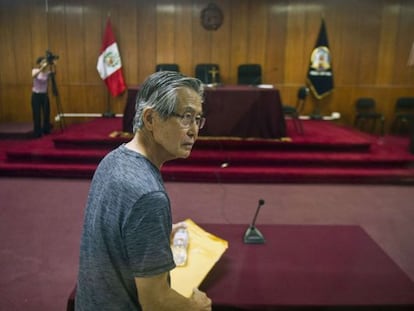Fujimori leads first round of voting in Peru but will likely face run off
Daughter of jailed former president has split electorate, and will be up against former minister

Keiko Fujimori, daughter of authoritarian ex-president Alberto Fujimori – who ran Peru with the support of the armed forces in the 1990s and was later jailed for human-rights violations – looks set to win the most votes in the first round of the Andean country’s election, but will likely now face one of her two rivals in a second round.
With 61% of the vote counted, Fujimori took 39%, former finance minister Pedro Pablo Kuczynski 24%, and leftist candidate Verónika Mendoza 17%.
Fujimori may be the most popular candidate, but her presence in this year’s presidential elections has proved divisive
“The new political map shows that Peru wants reconciliation and no more fighting,” said a jubilant Fujimori on Sunday evening in the capital of Lima.
Fujimori may be the most popular candidate, but her presence in this year’s presidential elections has proved divisive, and there is strong opposition to her from both right and left. Analysts say that if, as seems likely, center-right candidate Kuczynski, known as PPK, goes through to the second round on June 5, many supporters of Mendoza would vote for him to block Fujimori.
A visit to three polling stations in Lima – one in the wealthy San Isidro neighborhood, another in the middle-class Jesús María district, and one in the El Cercado working-class area – all confirm that whatever their intention, voters are fearful of a return to the violence and chaos of the 1980s and 1990s.
“I don't want any more experiments. I’ve seen them all,” says 72-year-old Luis, who lives in the Jesús María area of the city, home to Verónika Mendoza. “I lost 30 years of my life to terrorism, drug wars and dictatorships. I adored Fidel Castro when I was young, but that’s all gone now. We need to change things, but along the same lines.” He says he will vote for 77-year-old Kuczynski, who was finance minister under former president Alejandro Toledo between 2001 and 2002, and whose main selling point is his experience in office, although his relatively advanced years concern some voters.
I’m worried about Kuczynski’s age. I can’t make up my mind between him and Keiko
“I’m worried about PPK’s age. I can’t make up my mind between him and Keiko. The economy was good under Fujimori, but other things weren’t so good. Verónika frightens me, she’s like Humala, who supports the interior but has done nothing for Lima,” says Antonia, who lives in the working class El Cercado district, referring to outgoing president Ollanta Humala, a former general. Like many voters, she says she’ll make up her mind while waiting in line to vote, and is more likely to be swayed by her gut feelings toward a candidate, but she’s also afraid of a return to the authoritarian rule of Fujimori.
In the wealthy San Isidro neighborhood, support is near universal for Kuckzynski. “I’m going to vote for PPK, I’m not supporting any leftists,” says Pablo, who turned out to vote on Sunday. A young man who gives his name as Jorge says he will be voting for Alfredo Barnechea, also on the center right, but above all doesn't want Mendoza to win. “She’s pushing a model that everybody knows has failed around the world,” he concludes.
Electoral urns aboard canoes
Peru is a vast country, more than twice the size of Spain, and a third of it is inaccessible jungle with poor transport infrastructure. Around a fifth of the population of 30 million live in such remote rural areas. This means flying in voting slips and other material needed at election time, which is then usually transported by canoe to communities in the Amazon basin. After voting, it can take several days for urns to be collected and taken to Lima for counting.
Even though voting is obligatory by law in Peru, absenteeism is a particular problem in rural areas, mainly because people living there simply cannot afford to make the trip by boat or plane from remote communities to their nearest polling station, the only alternative being to walk several hours. Even today, many communities in Amazonian regions such as Ucuyali and Loreto can only be accessed by air.
Despite some improvements to the road network since the 1990s, rural areas still rely on dirt tracks where traffic accidents are frequent.
Charo is voting in the same polling station, but unlike the upper-middle-class voters around here, she is dark-skinned and clearly of Native American origin. She works in a nearby house as a maid, and says: “I’ll be voting for Verónika because she’s the only one who’s going to help the people.” Julio, a concierge who also works nearby, disagrees: “Verónika will be fine for the next elections, but she’s still too young [35], so now it’s the turn of PPK.”
Keiko Fujimori’s Lima power base is in the capital’s poorer districts. A polling station set up in a school in the El Cercado area was filled with working people on Sunday, most of them Native American or mixed race, many of them with small children in tow. Abdías, a welder, will be voting for Fujimori. “Her daddy governed well. I hope she does even better. She’s ready for the job,” he says. Carlos, a driver, agrees: “Her father did very good things, and she’s promised she won’t repeat the bad things.”
This year’s elections mark the first time in the country’s almost 200-year history that four consecutive terms in office have come to a peaceful, democratic conclusion. The country’s last coup was in 1992, when Alberto Fujimori, who had been elected in 1990, suspended the Constitution with army backing.
English version by Nick Lyne.
Tu suscripción se está usando en otro dispositivo
¿Quieres añadir otro usuario a tu suscripción?
Si continúas leyendo en este dispositivo, no se podrá leer en el otro.
FlechaTu suscripción se está usando en otro dispositivo y solo puedes acceder a EL PAÍS desde un dispositivo a la vez.
Si quieres compartir tu cuenta, cambia tu suscripción a la modalidad Premium, así podrás añadir otro usuario. Cada uno accederá con su propia cuenta de email, lo que os permitirá personalizar vuestra experiencia en EL PAÍS.
¿Tienes una suscripción de empresa? Accede aquí para contratar más cuentas.
En el caso de no saber quién está usando tu cuenta, te recomendamos cambiar tu contraseña aquí.
Si decides continuar compartiendo tu cuenta, este mensaje se mostrará en tu dispositivo y en el de la otra persona que está usando tu cuenta de forma indefinida, afectando a tu experiencia de lectura. Puedes consultar aquí los términos y condiciones de la suscripción digital.
More information
Últimas noticias
The complicated life of Francesca Albanese: A rising figure in Italy but barred from every bank by Trump’s sanctions
How Japan is trying to avert ‘digital defeat’
Reinhard Genzel, Nobel laureate in physics: ‘One-minute videos will never give you the truth’
Pinochet’s victims grapple with José Antonio Kast’s rise in Chile
Most viewed
- Pablo Escobar’s hippos: A serious environmental problem, 40 years on
- Why we lost the habit of sleeping in two segments and how that changed our sense of time
- Trump’s obsession with putting his name on everything is unprecedented in the United States
- The Florida Keys tourist paradise is besieged by immigration agents: ‘We’ve never seen anything like this’
- Charles Dubouloz, mountaineering star, retires at 36 with a farewell tour inspired by Walter Bonatti










































